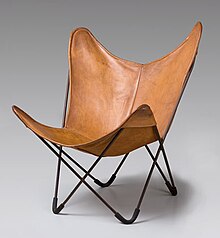Butterfly armchair
The Butterfly Chair (German: butterfly chair / chair) is also known as the bat chair , hardoy chair or BKF chair . The frame of the light and stackable armchair consists of curved full metal round profile bars with four permanently welded crossing points. Its covering, which is loosely attached to the bends in the frame with straps, is made of cloth or leather. Despite its ergonomically and aesthetically unfavorable low seating position, which is due to its constructive origin as a foldable cloth seat for travel, military and camping purposes it is one of the design classics of the 20th century.
history
The butterfly armchair was designed in 1938 by the Austral architectural office in Buenos Aires. The name BKF Chair, which is also often encountered, is composed of the first letters of the names of the three architects Antonio Bonet , Juan Kurchan and Jorge Ferrari-Hardoy who participated in the design . Ferrari-Hardoy was later recognized by Bonet and Kurchan as the actual creator of the chair. All three had practiced in 1937 in the architecture firm Le Corbusiers in Paris and worked as urban planners in Argentina. The butterfly chair was presented to the public for the first time in 1940 as part of the third Salon de Artistas Decoradores , an interior design fair in Buenos Aires . Since 1941 it has been part of the permanent exhibition of the New York Museum of Modern Art (MoMA) under the name Hardoy Butterfly Chair . In 1947 the couple Florence and Hans Knoll acquired the license to manufacture the chair. As a result, the Hardoy Butterfly Chair became a style icon of its time in the 1950s. In the Los Angeles area alone , it is said to have been sold up to 3,000 times a week. With the success, however, more and more foreign copies of the chair in varying quality came onto the market. Knoll Associates then tried to secure the sole production rights in court and failed. The court found that the chair was based directly on the English inventor Joseph Fenby's patented Tripolina folding chair from 1877. Bonet, Kuchan and Hardoy had neglected to legally protect their redesign of the Tripolina chair, which devalued their further design development into design common property. As a result, Knoll discontinued the production of the Hardoy Butterfly Chair after only three years of production. Since then, countless versions and variants of this public domain design have been marketed worldwide .
Individual evidence
- ↑ chair "Butterfly / Hardoy" . In: Beautiful living . ( schoener-wohnen.de [accessed December 11, 2017]).
